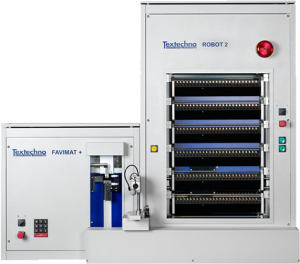Publications
This is a list of Textechno’s pulished articles in various forums. If you would like to read the full text of any article, please contact Textechno via the Contact form.
Standardizing the Single-Fibre Pull-Out Test for Fibre-Matrix Adhesion Characterization: Method and Insights
B. Leitner, F. Manis, S. Özcelik – Fraunhofer IGCV
C. Poitzsch, M. Khalid, E. Ingelsberger, S. Fliescher – Textechno Herbert Stein GmbH & Co. KG
A. Drieling, P. Hartwig, E. Dederer – Faserinstitut Bremen e. V.
Proceedings of the 6th International Conference and Exhibition on Thermoplastic Composites, ITHEC 2022.
The standardization of the micromechanical single-fibre pull-out test is urgently requested by the industry. The corresponding DIN SPEC 19289 “Fibre-reinforced Composites – Measurement of Interfacial Shear Strength by means of a Micromechanical Single-Fibre Pull-Out Test” was recently published within the scope of the publicly funded WIPANO project “WiPull”, which was conducted between the partners Fraunhofer IGCV, Faserinstitut Bremen and Textechno. This project also included testing of the most relevant thermoplastic matrices like PA6, PP, PEEK and PC in combination with carbon fibres, recycled carbon fibres, glass, and natural fibres. This paper includes key findings of the WiPull project including the impact of tempering, ageing, degradation, and temperature profiles on the measured fibre-matrix adhesion strength. Furthermore, results of the round robin trials are shown and discussed.
Find the full article here: https://publica.fraunhofer.de/entities/publication/b7311687-804d-4d96-b6ef-39684c834d56/details
Investigation of interfacial strength parameters in polymer matrix composites: Compatibility and reproducibility
Effects of various geometrical and physical factors, as well as the method of data reduction (analysis of experimental force–displacement curves) on the values of local interfacial strength parameters (local IFSS, τd, and critical energy release rate, Gic) determined by means of a single fiber pull-out test are discussed.
Serge Zhandarov, Edith Mäder, Christina Scheffler, Gerhard Kalinka, Claudia Poitzsch, Stefan Fliescher
Advanced Industrial and Engineering Polymer Research, Volume 1, Issue 1,2018, Pages 82-92
FIMATEST – A New Testing System to Determine the Fibre-Matrix Adhesion Strength by Means of Pull-Out Tests
Edith Mäder, Christina Scheffler, Andrea Miene, Stefan Fliescher, Ulrich Mörschel, Claudia Poitzsch
Proceedings of 56th Dornbirn-MFC (2017)
Textechno has a focus on the development of instruments for the characterization of the physical properties of reinforcement fibers, rovings and the fibre-matrix adhesion. We discuss in detail the measurement of the fibre-matrix adhesion strength by means of the FIMATEST system which has been developed together two research institutes, the Leibniz-Institut für Polymerforschung (IPF) in Dresden and the Faserinstitut Bremen (FIBRE). Read more
FIMATEST – Quality Assessment of Composites
JEC Composites Magazine No. 102, 2016, 49-51
The glass and carbon fibre industry continues to grow rapidly and into many new applications. A key quality characteristic of composite materials is the bond strength between fibre and matrix. This article describes the different mechanisms, as well as future testing solutions to ensure that a constant quality can be measured and achieved.
Testing of Carbon Fibers
The importance of carbon fibers as a reinforcement material in energy-saving lightweight composites is well accepted. Fast and reliable, i.e. automated, linear-density- and tensile testing of carbon fibers thus becomes increasingly important. Due to the special properties of carbon fibers an automatic handling of individual filaments has been considered to be problematic. TEXTECHNO in Mönchengladbach realizes an automated test of linear-density- and tensile properties on such carbon filaments in their automatic fiber test system FAVIMAT+ with ROBOT 2.
Read more
